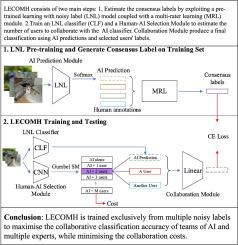学会与不同的人互补
IF 7.6
1区 计算机科学
Q1 COMPUTER SCIENCE, ARTIFICIAL INTELLIGENCE
引用次数: 0
摘要
解决现实世界图像分类挑战的解决方案。人类-人工智能协同分类(HAI-CC)旨在协同机器学习分类器的效率和人类专家的可靠性,以支持决策。学习延迟(L2D)是一种很有前途的HAI-CC方法,在这种方法中,系统评估一个样本,并在不确定时决定推迟给人类专家之一。尽管最近取得了进展,但现有的L2D方法依赖于对地面真值标签可用性的强假设来进行训练,而在实践中,大多数数据集通常包含每个数据样本的多个噪声注释,没有精心策划的地面真值标签。此外,当前的L2D方法要么考虑单个人类专家的设置,要么将决策推迟给一个人类专家,即使可能有多个专家可用,也会导致可用资源的次优利用。此外,当前的HAI-CC评估框架往往忽略了处理成本,使得在对不同方法进行基准测试时难以评估计算效率和性能之间的权衡。为了解决这些差距,本文引入了LECOMH——一种新的HAI-CC方法,它从有噪声的标签中学习,而不依赖于干净的标签进行训练,同时最大化与一个或多个人类专家的协作准确性,同时最小化人类协作的成本。本文还介绍了用于训练和测试的每个数据样本具有多个噪声标签的基准,以评估HAI-CC方法。通过对这些基准的定量比较,LECOMH始终优于HAI-CC方法和基线,包括在合成和真实数据集上单独使用人类专家、多评分学习和噪声标签学习方法。本文章由计算机程序翻译,如有差异,请以英文原文为准。

Learning to complement with multiple humans
Solution for addressing real-world image classification challenges. Human-AI collaborative classification (HAI-CC) aims to synergise the efficiency of machine learning classifiers and the reliability of human experts to support decision making. Learning to defer (L2D) has been one of the promising HAI-CC approaches, where the system assesses a sample and decides to defer to one of human experts when it is not confident. Despite recent progress, existing L2D methods rely on the strong assumption of ground truth label availability for training, while in practice, most datasets often contain multiple noisy annotations per data sample without well-curated ground truth labels. In addition, current L2D methods either consider the setting of a single human expert or defer the decision to one human expert, even though there may be multiple experts available, resulting in a suboptimal utilisation of available resources. Furthermore, current HAI-CC evaluation frameworks often overlook processing costs, making it difficult to assess the trade-off between computational efficiency and performance when benchmarking different methods. To address these gaps, this paper introduces LECOMH – a new HAI-CC method that learns from noisy labels without depending on clean labels for training, simultaneously maximising collaborative accuracy with either one or multiple human experts, while minimising the cost of human collaboration. The paper also introduces benchmarks featuring multiple noisy labels per data sample for both training and testing to evaluate HAI-CC methods. Through quantitative comparisons on these benchmarks, LECOMH consistently outperforms HAI-CC methods and baselines, including human experts alone, multi-rater learning and noisy-label learning methods across both synthetic and real-world datasets.
求助全文
通过发布文献求助,成功后即可免费获取论文全文。
去求助
来源期刊

Pattern Recognition
工程技术-工程:电子与电气
CiteScore
14.40
自引率
16.20%
发文量
683
审稿时长
5.6 months
期刊介绍:
The field of Pattern Recognition is both mature and rapidly evolving, playing a crucial role in various related fields such as computer vision, image processing, text analysis, and neural networks. It closely intersects with machine learning and is being applied in emerging areas like biometrics, bioinformatics, multimedia data analysis, and data science. The journal Pattern Recognition, established half a century ago during the early days of computer science, has since grown significantly in scope and influence.
 求助内容:
求助内容: 应助结果提醒方式:
应助结果提醒方式:


